Are your feet aching from all that hiking? Find relief for your plantar fasciitis by soaking your feet in Epsom salt. Plantar fasciitis sufferers have come to rely on Epsom salt foot soaks as a natural remedy for alleviating pain. Now you might be wondering, how long should I soak my feet after hiking?
Soaking for about 15 to 20 minutes can work wonders. Not only does Epsom salt help reduce inflammation and pain, but it also promotes relaxation. So why suffer when a simple soak can bring you much-needed relief?
Let’s dig deeper and learn more about how to soak your feet in Epsom salt for plantar fasciitis due to hiking and how it can benefit you.
How Do You Soak Your Feet in Epsom Salt for Plantar Fasciitis from Hiking?
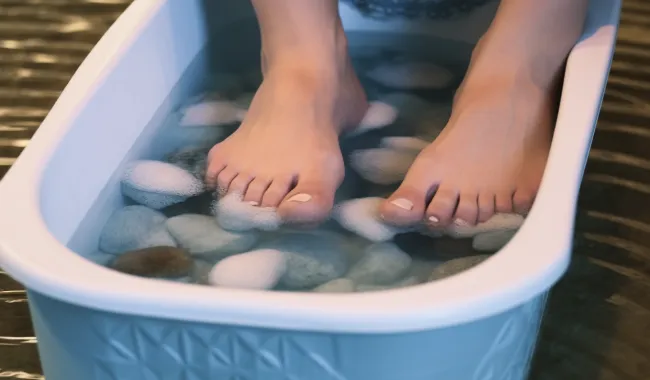
To take advantage of the benefits of an Epsom salt foot soak within time frame of 15-20 minutes, you need to follow several steps: Here are steps:
- Step 01: Prepare the Epsom salt solution
- Step 02: Soak your feet
- Step 03: Massage your feet
- Step 04: Dry your feet
- Step 05: Moisturize and elevate
- Step 06: Repeat as needed
Let’s take a closer look at each step:
Step 01: Prepare the Epsom Salt Solution
First, fill the large bucket or plastic bin with warm water that is comfortably warm, not too hot. This is an important step in preparing the Epsom salt solution for soaking your feet in case of plantar fasciitis after hiking.
Once the water is at the right temperature, gradually add the recommended amount of Epsom salt to the water. The packaging of the Epsom salt will typically indicate how much salt to use, which is usually about 1/2 to 1 cup for a large bucket of water.
After adding the salt, gently stir the water using your hand or a long spoon to help the Epsom salt dissolve. This ensures that the solution is well-mixed and ready for soaking your feet to provide relief for plantar fasciitis.
Step 02: Soak Your Feet
Next, make sure the water covers your feet and ankles comfortably as you relax and let the Epsom salt potentially ease discomfort and relax your muscles. Soaking your feet in Epsom salt for plantar fasciitis can relieve hiking-related pain.
Here’s why it works:
- Magnesium is found in Epsom salt and is known to reduce inflammation and promote muscle relaxation.
- The warm water helps increase circulation, allowing the salt to penetrate deeper into the tissues.
- Soaking your feet for 15 to 20 minutes allows enough time for the Epsom salt to work its magic.
Step 03: Massage Your Feet
While soaking, take the time to massage your feet, concentrating on any areas with intense pain. A gentle massage can help break up thick scar tissue and stimulate blood flow to the area.
Pay extra attention to the arches, heels, and balls of your feet, as plantar fasciitis commonly affects these areas. Continue massaging for about 5 to 10 minutes or until you feel relief. Remember to listen to your body and adjust the pressure accordingly.
Massaging your feet can help increase blood circulation, relax the muscles, and alleviate discomfort caused by plantar fasciitis sustained while hiking.
Step 04: Dry Your Feet
Once the soaking time is up, carefully lift your feet out of the water and pat them dry using a clean towel. Drying your feet properly after an Epsom salt soak is important in maintaining foot health and preventing further issues. Here’s why it’s crucial to dry your feet thoroughly:
- Prevents moisture buildup: Drying your feet helps to remove any excess moisture from the skin, reducing the risk of fungal or bacterial infections.
- Reduces friction: Dry feet are less prone to friction, which can lead to blisters and calluses. Properly drying your feet can help prevent these uncomfortable conditions.
- Enhances absorption: By drying your feet, you prepare the skin for the next step in your foot care routine, such as applying moisturizer or utilizing orthotics, allowing them to work more effectively.
Step 05: Moisturize and Elevate (Optional)
After properly drying your feet, it’s time to moisturize and elevate them for added relief and hydration.
Applying a moisturizer or foot cream to your feet after soaking helps to keep the skin hydrated and prevent dryness and cracking. Look for a moisturizer specifically designed for feet, as these often contain ingredients like shea butter or glycerin that provide intense hydration.
Gently massage the moisturizer into your feet, focusing on the heels and any areas that feel particularly dry or rough.
After moisturizing, elevate your feet to further reduce swelling caused by plantar fasciitis due to hiking. Prop them up on a pillow or use a footrest to elevate them above heart level for about 15 to 20 minutes. This will help promote better blood circulation and alleviate discomfort.
Step 06: Repeat as Needed
You can continue this foot care routine regularly to maintain moisturization and alleviate discomfort caused by plantar fasciitis. It is recommended to soak your feet in Epsom salt a few times per week, especially after hiking or when experiencing plantar fasciitis-related discomfort.
By incorporating regular foot soaks into your routine, you can help manage the symptoms of plantar fasciitis and promote overall foot health. Remember to consult a healthcare professional if your symptoms persist or worsen.
Benefits of Using Epsom Salt for Plantar Fasciitis after Hiking
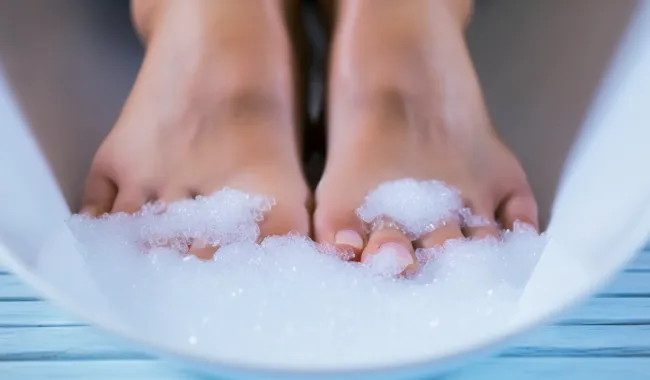
If you’re seeking relief from the pain and discomfort caused by plantar fasciitis from hiking, soaking your feet in Epsom salt can provide multiple benefits. Here are just a few:
- Muscle relaxation
- Reduced swelling
- Improved circulation
- Possible foot skin benefits
- Promotes self-care
Let’s see each of these benefits in more detail.
1. Pain Relief
Epsom salt is believed to have anti-inflammatory properties. Soaking your feet in an Epsom salt solution might help alleviate some of the pain and discomfort associated with plantar fasciitis, especially after a long hike that can exacerbate the condition.
2. Muscle Relaxation
After a tiring hike, you should relax your muscles and reduce tension for overall well-being. When you hike, your feet and leg muscles can become tense and fatigued, causing discomfort, especially if you have plantar fasciitis.
Soaking your feet in Epsom salt can alleviate some of this tension and promote relaxation. Epsom salt contains magnesium, which is known to help ease muscle soreness and decrease muscle tension.
3. Reduced Swelling
The warm water and Epsom salt combination help decrease swelling in the feet and ankles, providing relief after a strenuous hiking session that may have caused plantar fasciitis. It will also help decrease inflammation of the affected area, making it easier for you to walk afterward.
4. Improved Circulation
Soaking your feet in a warm Epsom salt bath can help stimulate blood flow and improve circulation.
Dissolved in warm water releases magnesium ions that can be absorbed through the skin, promoting blood vessel dilation and increasing blood flow to the feet. This increased circulation can help reduce swelling and relieve conditions such as plantar fasciitis.
5. Possible Foot Skin Benefits
You might notice that your foot skin feels smoother and more supple after using Epsom salt to exfoliate your feet. This natural remedy has several possible skin benefits that can enhance your feet’ overall health and appearance.
Here are three key advantages of using Epsom salt for your feet:
- Exfoliation: Epsom salt acts as a gentle exfoliant, removing dead skin cells and promoting the growth of new, healthy skin. This can help soften rough patches and calluses, making your feet feel silky smooth.
- Hydration: Epsom salt has hydrating properties that can moisturize your skin and prevent dryness. It helps to attract water to the skin’s surface, keeping it plump and nourished.
- Detoxification: Epsom salt can draw out toxins and impurities from your feet, leaving them feeling refreshed and revitalized. It can help to eliminate bacteria and reduce foot odor.
6. Promotes Self-Care
Take a moment to prioritize your well-being by incorporating Epsom salt into your foot care routine. Not only can soaking your feet in Epsom salt relieve conditions like plantar fasciitis from hiking, but it can also promote self-care and overall wellness.
Do Epsom salt foot soaks for plantar fasciitis on hikes carry any risks?
For most adventure hikers, Epsom salt foot soaks are safe for plantar fasciitis. However, individuals with certain medical conditions, such as diabetes or skin infections, should consult a doctor before trying them. Always monitor your skin’s reaction and discontinue if you notice any adverse effects.
Can I rinse my feet after soaking in Epsom salts while hiking?
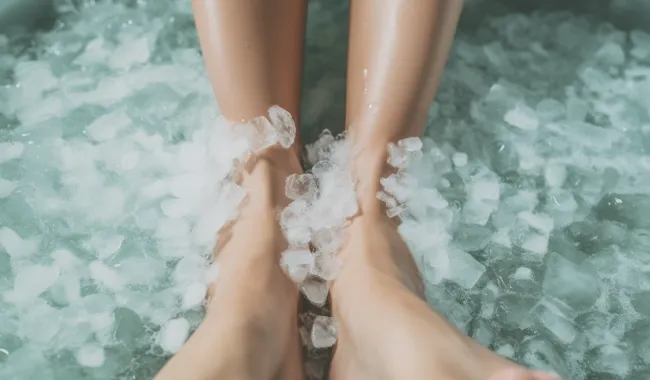
Following an Epsom salt foot soak for plantar fasciitis caused by hiking, it’s generally not necessary to rinse off the residue left on your feet. In fact, leaving the Epsom salt residue can provide some continued benefits.
The residue contains magnesium and sulfate, which can be absorbed through the foot skin and help to relax muscles, reduce inflammation, and alleviate pain. However, if the residue is uncomfortable or sticky, rinse your feet with warm water. Make sure not to use soap, as it can wash away the beneficial minerals.
Take Epsom Salt Foot Soaks to Relieve Plantar Fasciitis Caused by Hiking
Incorporating Epsom salt foot soaks into your post-hiking routine to manage plantar fasciitis discomfort presents a potentially beneficial strategy. The magnesium-rich Epsom salt and warm water may temporarily relieve pain, aid muscle relaxation, and offer a calming experience.
As with any health-related approach, moderation is key. Adhering to recommended soaking times and considering your skin’s sensitivity will help you optimize the benefits.
While Epsom salt foot soaks can be a valuable addition to your self-care regimen, you should remember that they should complement, not replace, professional medical advice.
If your plantar fasciitis symptoms persist or worsen, consulting a healthcare professional remains the best course of action for a comprehensive treatment plan tailored to your individual needs.
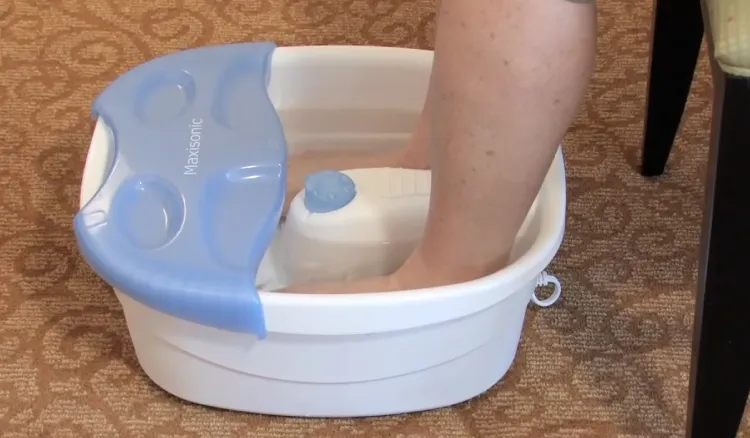
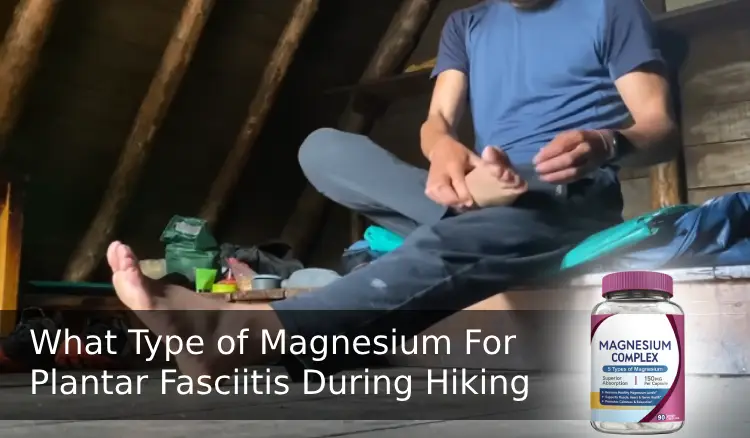

Leave a Reply